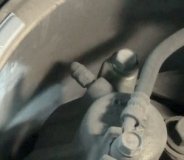Master cylinder testing
Apply and hold brake pedal look for bubbles or fluid swirl at compensating port in reservoir. If so Replace master cylinder.
Bleed the brakes from RR, LR, RF, LF
Bleeding the brakes should be the last step in a brake job. Opening the bleeder screws at the calipers and wheel cylinders allows you to drain, flush or siphon the old fluid from the brake lines and replace it with new. Bleeding the brakes is always necessary if a brake line has been opened, or if a caliper, wheel cylinder, master cylinder or ABS hydraulic modulator or pump has been replaced.
Bleeding is well worth the effort because it removes air from the lines that could cause a soft pedal (air is compressible while hydraulic fluid is not). It also replaces the old moisture-contaminated brake fluid with fresh, clean fluid. After several years of service, brake fluid is often saturated with water. As the moisture content goes up, the fluid's boiling temperature goes down. This increases the risk of fluid boil and loss of pedal under hard use.
Though most brake systems are designed with enough cooling capacity to prevent the fluid from boiling under normal driving conditions, the built-in safety margin can vanish under prolonged hard braking (as when driving down a steep mountain in a heavily loaded vehicle). Fortunately, this kind of brake failure is rare, but it can happen, and often with tragic consequences.
A more common problem is a soft pedal following a brake job or other brake repairs. When brake lines are opened or hydraulic parts are replaced, air enters the system. Air may also be trapped inside new components. Bench bleeding a new master cylinder will remove most of the air from the unit before it is installed, but the brake lines, calipers and wheel cylinders must still be bled after these or other parts have been installed to get the air out.
When air is trapped inside the hydraulic system, it usually migrates to the highest point. This may be the master cylinder, but it can also be trapped behind the caliper or wheel cylinder pistons, or inside an ABS unit.
When you step on the brake pedal, the trapped air compresses causing the pedal to travel farther than normal. Instead of a nice firm pedal, the pedal feels soft and spongy. If there is a lot of air in the system, the pedal may go all the way to the floor without applying the brakes! Pumping furiously may recover enough pedal to stop the vehicle, but this is not something you want to ever experience firsthand.
Air in the lines can also upset brake balance and the normal application of the brakes. If one caliper contains air, it won't apply with as much force as the caliper on the opposite wheel. This can cause a brake pull towards the stronger side.
When the brakes are bled, the goal should be to get all the air out of the system and to replace all of the old dirty fluid with fresh clean fluid. This will assure a firm pedal and restore the corrosion-inhibitors and lubricants that help protect the metal and rubber parts inside the brake system. Use the type of fluid (DOT 3 or 4) specified by the vehicle manufacturer.
How you bleed the brakes is up to you. Gravity bleeding is a slow and tedious process. Manually bleeding the brakes is faster because pumping the brake pedal pushes fluid through the lines. But manual bleeding requires a helper (someone to pump the pedal while you open and close the bleeder screws), unless you use one-way check valves on the bleeder screws to prevent air from being siphoned back into the system during the pedal return stroke.
A much faster technique is to pressure bleed the lines. By attaching a pressure tank to the master cylinder reservoir, you can force fluid through the lines to quickly bleed the system. Pressure bleeding requires the right adapter for the vehicle being bled. On some vehicles, the metering valve or "hold-off" valve must also be held open while pressure bleeding because the power bleeder doesn't generate enough pressure (usually 15 to 20 psi) to open the metering valve by itself.
Vacuum bleeding is another technique that works well and saves time. With this method, a vacuum bleeding tool is attached to the bleeder screws to pull fluid through the system. The tool uses shop air to create a vacuum that siphons fluid out of the system. Just remember to keep the master cylinder full of fluid so it doesn't run low and allow air to reenter the system.
Regardless of which technique you use to bleed the brakes, follow the recommended bleeding sequence for the vehicle you are bleeding otherwise you might not get all the air out of the system. On some ABS-equipped vehicles, you may also have to cycle or reposition the ABS solenoids or valves with a scan tool. Many also have additional bleeder screws on the ABS unit for bleeding the system.
Monday, April 27th, 2009 AT 7:37 AM


